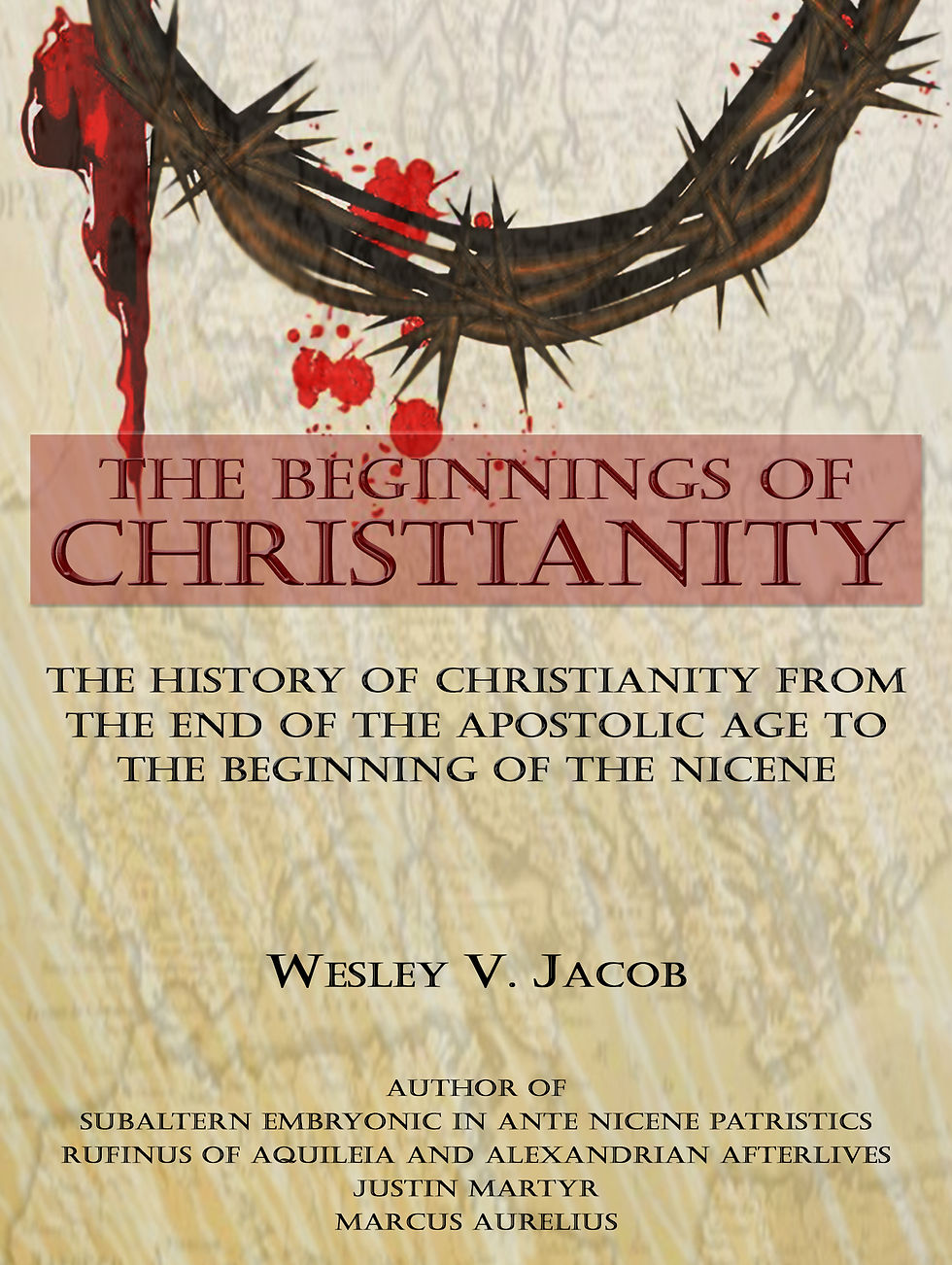The historical development of Christianity from the end of the Apostolic Age to the formulation of the Nicene Creed (325 AD) represents one of the most transformative periods in Christian history. During this time, the fledgling Christian movement evolved from a small, persecuted sect within the Roman Empire into an organized, doctrinally robust faith capable of influencing both the theological and political landscapes of the known world. This essay will examine the theological, ecclesiastical, and philosophical dynamics that defined early Christian thought, focusing on the transition from apostolic authority to the establishment of patristic orthodoxy. To elevate the discussion, I will integrate both patristic sources and recent scholarly developments, framing the argument within the context of cutting-edge discoveries and contemporary theological discourse.
The End of the Apostolic Age and the Rise of Christian Communities

With the passing of the last apostles, particularly John at the end of the first century, the Christian community faced new challenges. Without apostolic authority, questions surrounding orthodoxy and authority emerged. Early Christians had to discern how to preserve the teachings of Jesus and the apostles amidst external persecution and internal doctrinal disputes. As Irenaeus writes, “the Church, though dispersed throughout the whole world, even to the ends of the earth, has received from the apostles and their disciples this faith.” He emphasizes the continuity of apostolic tradition as a safeguard against heretical interpretations that began to proliferate during this time.
The writings of early Church Fathers such as Clement of Rome, Ignatius of Antioch, and Polycarp serve as critical bridges between the Apostolic Age and the Patristic period. Ignatius, in his epistles, stresses the importance of unity under episcopal leadership to maintain doctrinal purity, affirming that “where the bishop is, there let the people be; even as where Jesus Christ is, there is the Church.” This principle of episcopal authority would become a cornerstone of early ecclesiology, particularly as the Church navigated through successive waves of Roman persecution.
Ecclesial Identity and the Emergence of Orthodoxy
One of the key theological challenges during this period was the rise of Gnosticism, which threatened the unity of the Christian message by introducing dualistic interpretations of creation, redemption, and the nature of Christ. Gnostic thinkers such as Valentinus offered a secretive, esoteric faith that contrasted sharply with the public, incarnational theology of the early Church. Irenaeus, in Against Heresies, systematically dismantled Gnostic claims, affirming that God’s creation is inherently good and that salvation comes through the incarnation and resurrection of Christ. Irenaeus’ defense of orthodoxy against Gnostic cosmology reveals the theological sophistication of early Christian thought, as well as the Church’s emphasis on the continuity of apostolic teaching.
The establishment of the canon was another vital step in the consolidation of early orthodoxy. While the New Testament canon was not formally recognized until the fourth century, early Christian communities had already begun circulating and accepting certain texts as authoritative. As Eusebius of Caesarea notes in his Ecclesiastical History, by the early third century, the Gospels, Pauline epistles, and certain other texts were widely recognized as scriptural. This canonical formation provided the foundation for theological and liturgical cohesion across the Christian world, ensuring that the teachings of the apostles were preserved and transmitted to subsequent generations.
Theological Debates and the Road to Nicaea
The pre-Nicene period is characterized by intense theological debates, particularly regarding the nature of Christ and the Trinity. The question of how to understand the relationship between the Father and the Son became a central issue, as various heresies such as Arianism began to surface. Arius, a presbyter from Alexandria, argued that the Son was a created being, distinct and subordinate to the Father. This position provoked a theological crisis, as it contradicted the Church’s developing understanding of Christ’s divinity. Athanasius, then a deacon and later bishop of Alexandria, emerged as a leading defender of Trinitarian orthodoxy, famously asserting that “the Son is of the same substance (homoousios) as the Father.”
The Council of Nicaea in 325 AD, convened by Emperor Constantine, marked a pivotal moment in Christian history. The Nicene Creed, formulated at this council, established the consubstantiality of the Son with the Father and condemned Arianism as heresy. This creedal definition would serve as the foundation for later theological developments and remains a key component of Christian orthodoxy. As Gregory of Nazianzus reflects, “the Trinity is a great mystery… but we know that the Son is not a creature, but of one essence with the Father.”
The Role of Patristic Fathers and Theological Development
The patristic fathers of the second and third centuries played a crucial role in shaping early Christian thought. Figures such as Justin Martyr, Tertullian, Origen, and Cyprian of Carthage offered profound reflections on the nature of God, Christology, and ecclesiology. Justin Martyr’s Dialogue with Trypho represents one of the earliest attempts to engage in theological dialogue with Judaism, demonstrating Christianity’s intellectual engagement with contemporary philosophical and religious currents. Meanwhile, Tertullian’s Apology articulated a robust defense of Christian monotheism against pagan critiques, coining the term Trinitas to describe the unity of Father, Son, and Holy Spirit.
Origen, often regarded as the greatest theologian of the early Church, developed a sophisticated system of biblical interpretation, emphasizing both the literal and allegorical meanings of Scripture. His On First Principles laid the groundwork for subsequent theological developments in areas such as creation, Christology, and eschatology. However, Origen’s speculative theology would later come under scrutiny, particularly during the post-Nicene period, when certain of his views were condemned.
The writings of these patristic thinkers not only provided theological clarity but also shaped the spiritual life of early Christians. As A.W. Tozer observes, “what comes into our minds when we think about God is the most important thing about us.” This emphasis on the nature of God and the believer’s relationship with the divine permeates the works of the Church Fathers, offering a rich tapestry of theological and mystical reflection.
Contemporary Insights: James Webb Space Telescope and the Cosmos
Recent advancements in astronomy, particularly the discoveries from the James Webb Space Telescope, have provided a new dimension to theological discussions about creation and the nature of the cosmos. As the Webb Telescope reveals unprecedented details about the universe’s structure and origins, theologians are prompted to re-examine the relationship between scientific knowledge and divine revelation. These cutting-edge discoveries open up new avenues for reflecting on early Christian doctrines of creation, which emphasized God’s creative wisdom and providence in fashioning the universe.
Early Christian thinkers such as Basil the Great and Augustine of Hippo celebrated the order and beauty of creation as a reflection of God’s wisdom. In his Hexaemeron, Basil writes, “The world was called forth from non-being into being by the word of God.” Contemporary reflections on creation now intersect with findings from cosmology and astrophysics, offering renewed perspectives on theological questions regarding the universe’s origins and God’s ongoing creative activity.
Conclusion
The period between the end of the Apostolic Age and the Council of Nicaea is marked by profound theological, ecclesial, and philosophical developments. The transition from apostolic authority to patristic orthodoxy, the challenges of Gnostic heresies, the formation of the canon, and the crystallization of Trinitarian theology all contributed to the maturation of the Christian faith. As the James Webb Space Telescope continues to unveil the mysteries of the cosmos, contemporary theologians are called to integrate scientific discoveries with the rich theological heritage of early Christianity. Through this interdisciplinary dialogue, the Church can continue to affirm its foundational truths while engaging with the intellectual currents of the modern world.
I provide you an expanded bibliography focusing primarily on the writings of the Apostolic Fathers, Ante-Nicene Fathers, and Post-Nicene Fathers, providing a comprehensive resource for scholarly research on early Christian theology and history.
Expanded Bibliography
Apostolic Fathers
1. Barnabas. The Epistle of Barnabas. Translated by Michael W. Holmes. In The Apostolic Fathers, Vol. 1. Edited by Bart D. Ehrman. Cambridge, MA: Harvard University Press, 2003.
2. Clement of Rome. First Epistle of Clement to the Corinthians. Translated by Bart D. Ehrman. In The Apostolic Fathers, Vol. 1. Cambridge, MA: Harvard University Press, 2003.
3. Clement of Rome. Second Epistle of Clement to the Corinthians. Translated by Michael W. Holmes. In The Apostolic Fathers, Vol. 1. Cambridge, MA: Harvard University Press, 2003.
4. Ignatius of Antioch. The Epistles of Ignatius of Antioch. Translated by Michael W. Holmes. In The Apostolic Fathers, Vol. 1. Cambridge, MA: Harvard University Press, 2003.
5. Polycarp. The Epistle of Polycarp to the Philippians. Translated by Bart D. Ehrman. In The Apostolic Fathers, Vol. 1. Cambridge, MA: Harvard University Press, 2003.
6. Shepherd of Hermas. The Shepherd of Hermas. Translated by Michael W. Holmes. In The Apostolic Fathers, Vol. 1. Cambridge, MA: Harvard University Press, 2003.
Ante-Nicene Fathers
7. Irenaeus of Lyons. Against Heresies. Translated by Dominic J. Unger. New York: Paulist Press, 1992.
8. Tertullian. Apology. Translated by Thomas R. McGinnis. In The Ante-Nicene Fathers, Vol. 3. Edited by Alexander Roberts and James Donaldson. Grand Rapids, MI: Eerdmans, 1956.
9. Tertullian. On the Prescription of Heretics. Translated by Peter Holmes. In The Ante-Nicene Fathers, Vol. 3. Grand Rapids, MI: Eerdmans, 1956.
10. Justin Martyr. First Apology. Translated by Thomas B. Falls. Washington, D.C.: Catholic University of America Press, 2003.
11. Justin Martyr. Second Apology. Translated by Thomas B. Falls. Washington, D.C.: Catholic University of America Press, 2003.
12. Origen. On First Principles. Translated by G.W. Butterworth. New York: Harper & Row, 1966.
13. Hippolytus. The Refutation of All Heresies. Translated by Bart D. Ehrman. In The Ante-Nicene Fathers, Vol. 5. Edited by Alexander Roberts and James Donaldson. Grand Rapids, MI: Eerdmans, 1956.
14. Cyprian of Carthage. The Letters of St. Cyprian of Carthage. Translated by Roger Pearse. London: 2006.
15. Methodius of Olympus. The Banquet of the Ten Virgins. Translated by William R. Schoedel. In The Ante-Nicene Fathers, Vol. 6. Grand Rapids, MI: Eerdmans, 1956.
Post-Nicene Fathers
16. Augustine of Hippo. City of God. Translated by Henry Bettenson. London: Penguin Classics, 2003.
17. Augustine of Hippo. Confessions. Translated by Henry Chadwick. Oxford: Oxford University Press, 1991.
18. Gregory of Nazianzus. Theological Orations. Translated by Frederick Williams and Lionel R. Wickham. Crestwood, NY: St. Vladimir’s Seminary Press, 2002.
19. Basil the Great. Hexaemeron. Translated by Blomfield Jackson. In Nicene and Post-Nicene Fathers, Second Series, Volume VIII. Grand Rapids, MI: Eerdmans, 1955.
20. John Chrysostom. Homilies on the Gospel of John. Translated by George Prevost. In Nicene and Post-Nicene Fathers, Second Series, Volume XIV. Grand Rapids, MI: Eerdmans, 1956.
21. Athanasius. On the Incarnation. Translated by Sister Penelope Lawson. Crestwood, NY: St. Vladimir’s Seminary Press, 1996.
22. Eusebius of Caesarea. Ecclesiastical History. Translated by Paul L. Maier. Grand Rapids, MI: Kregel Publications, 1999.
23. Jerome. The Lives of Illustrious Men. Translated by Ernest Cushing Richardson. In Nicene and Post-Nicene Fathers, Second Series, Volume III. Grand Rapids, MI: Eerdmans, 1956.
24. John of Damascus. Exposition of the Orthodox Faith. Translated by S. D. F. Salmond. In Nicene and Post-Nicene Fathers, Second Series, Volume IX. Grand Rapids, MI: Eerdmans, 1956.
25. Thomas Aquinas. Summa Theologica. Translated by the Fathers of the English Dominican Province. New York: Benziger Bros., 1947.
Additional Resources
26. MacArthur, John. The Truth War: Fighting for Certainty in an Age of Deception. Nashville: Thomas Nelson, 2007.
27. Stott, John. Basic Christianity. Downers Grove, IL: InterVarsity Press, 2006.
28. Sproll, R.C. Knowing Scripture. Downers Grove, IL: InterVarsity Press, 2009.
29. Lennox, John. God and Stephen Hawking: Whose Design Is It Anyway? Grand Rapids, MI: Zondervan, 2011.
30. Chesterton, G.K. Orthodoxy. San Francisco: Ignatius Press, 1995.





Comentários